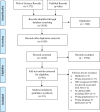The genetic risk of Alzheimer's disease beyond APOE ε4: systematic review of Alzheimer's genetic risk scores
- PMID: 30143603
- PMCID: PMC6109140
- DOI: 10.1038/s41398-018-0221-8
The genetic risk of Alzheimer's disease beyond APOE ε4: systematic review of Alzheimer's genetic risk scores
Abstract
The ε4 allele of Apolipoprotein E (APOE) is the strongest known genetic risk factor of Alzheimer's disease (AD) but does not account for the entirety of genetic risk. Genetic risk scores (GRSs) incorporating additional genetic variants have been developed to determine the genetic risk for AD, yet there is no systematic review assessing the contribution of GRSs for AD beyond the effect of APOE ε4. The purpose of this systematic PRISMA (Preferred Reporting Items for Systematic Reviews and Meta-analyses)-based review was to summarize original research studies that have developed and validated a GRS for AD utilizing associated single nucleotide polymorphisms (SNPs). The PubMed and Web of Science databases were searched on April 6, 2018 and screening was completed on 2018 citations by two independent reviewers. Eighteen studies published between 2010 and 2018 were included in the review. All GRSs expressed significant associations or discrimination capability of AD when compared to clinically normal controls; however, GRS prediction of MCI to AD conversion was mixed. APOE ε4 status was more predictive of AD than the GRSs, although the GRSs did add to AD prediction accuracy beyond APOE ε4. GRSs might contribute to identifying genetic risk of AD beyond APOE. However, additional studies are warranted to assess the performance of GRSs in independent longitudinal cohorts.
Conflict of interest statement
The authors declare that they have no conflict of interest.
Figures
References
Publication types
MeSH terms
Substances
LinkOut - more resources
Full Text Sources
Other Literature Sources
Medical
Miscellaneous


